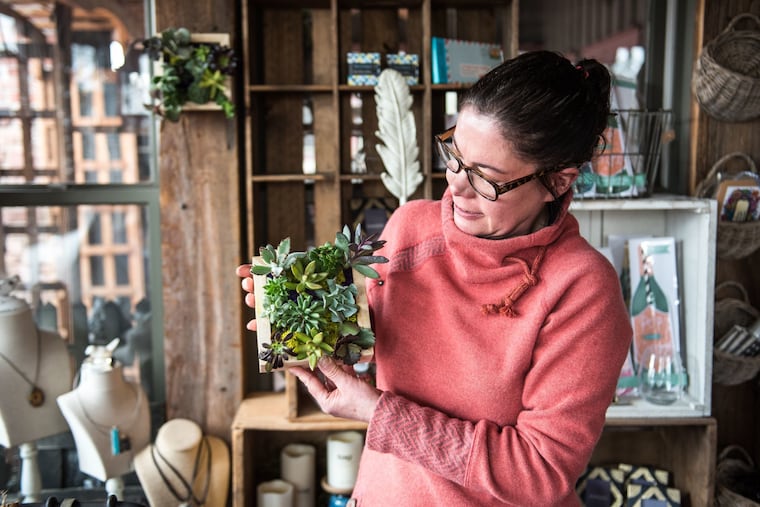A local succulent expert takes the hippest houseplant to the next level
Love succulents? Here's how to make a wall-hanging planter in eight easy steps, according to Floral & Hardy's Amy Scipioni.

Not everyone is graced with a green thumb. For those who aren’t, the solution is succulents — the low-maintenance plants that have seen a massive spike in popularity in recent years.
“It’s hard to find a plant much easier to take care of than a succulent,” said Amy Scipioni, the buyer for Skippack’s Floral and Hardy. The broad category includes cacti, aloe vera, jade plants, and snake plants. And far from needing regular watering, these dry-climate natives "really just want neglect,” Scipioni said.
Scipioni is one of more than 240 experts presenting at this weekend’s Philly Home and Garden Show. Attendees can learn about the latest design trends, explore a 7,500-square-foot gardening area, and partake in hands-on workshops — like her succulent planter project.
For those who can’t make the show, Scipioni shares this DIY succulent picture-frame project, which can spruce up even the smallest of spaces.
The Philly Home and Garden Show runs Feb. 15-17 at the Greater Philadelphia Expo Center at Oaks. 11 a.m. to 9 p.m. Friday, 10 a.m. to 9 p.m. Saturday, 10 a.m. to 6 p.m. Sunday, Greater Philadelphia Expo Center at Oaks, 100 Station Ave., Oaks, $11 online, $9 at the door, free for children, 610-940-1677, phillyhomeandgarden.com
Materials
6-by-6-inch SuperMoss Sphagnum Moss Living Frame — available at select garden stores and online for around $20. (If you purchase a larger frame, buy more plants and reindeer moss accordingly.)
10 to 15 succulents — choose a variety of types; succulents with longer stems will be placed in the corners of the frame, while shorter and flatter succulents are best to fill the center.
Needle-nose wire cutters
A paintbrush, pencil, chopstick, or other thin utensil
1 to 2 cups of reindeer moss — available online, in arts and crafts and some hardware stores; comes in a wide variety of colors.
Plant mister, turkey baster, or small-holed watering can
Gloves (optional)
STEP 1
Use the plant mister to dampen the sphagnum moss in the frame with about ⅛ cup water. The water should just moisten the moss — you don’t want it seeping out of the frame. Then, pick out the four longest succulents, which will be placed in each corner of the frame to allow the longer plants to cascade over the sides.
STEP 2
Take note of how the frame will hang on the wall. Near each corner of the frame, make a square opening with the wire cutters: Clip three or four wires in the mesh in three directions, leaving one side of the square intact to form a wire flap. Always err on the side of cutting less mesh; you can cut more as you go along.
STEP 3
Pull back the cut wire and use your finger to push down on the sphagnum moss, creating an opening for the succulent. Insert one of the larger plants by gently pressing down on its plug — the dirt square attached to its roots — and easing it into the opening. If any dirt ends up on the plants, to avoid damaging them, use a paintbrush to brush it off.
STEP 4
Use your hands to gently rearrange the attached flap of wire mesh around the plant’s base. If needed, cut the wire flap down the middle and tuck the mesh on either side of the plant to secure it.
STEP 5
To hide the mesh around each succulent, use the tip of the paintbrush to stuff a bit of reindeer moss into the mesh holes. The moss can remain somewhat loose; it will cling to the wires.
STEP 6
Repeat steps 3, 4, and 5 for the other three corners of the frame.
STEP 7
To fill the middle of the frame, repeat steps 3, 4, and 5, working your way from the edges to the center, cutting openings and inserting succulents. Leave two to four rungs of mesh between each succulent.
If at any point you accidentally cut all four sides of the mesh — removing the flap — stuff reindeer moss around the succulent’s base to secure it. Once the plants fill the frame, plug any bare spaces with more reindeer moss.
STEP 8
Leave the frame to lay flat for one week so the plants can take root. After that, hang it on the wall. Succulents thrive best in direct light or in an area where indirect light is available for at least six hours each day. Place the frame in a dry area (avoid a moist environment, such as a bathroom). If at any point one of the succulents starts to wither, replace it with a new one.
Maintenance
Water the living frame every seven to 10 days. If it’s placed in indirect light, every 10 days should suffice. To water the plants, remove the frame from the wall and lay it flat on top of a newspaper or plastic bag. (The dye in the reindeer moss can bleed.) Place about five small ice cubes in between the plants. If you only have larger ice cubes, break them into smaller pieces, or use a turkey baster to squirt just a bit of water in between each plant, ideally pushing the tip of the baster below the reindeer moss.